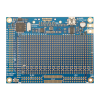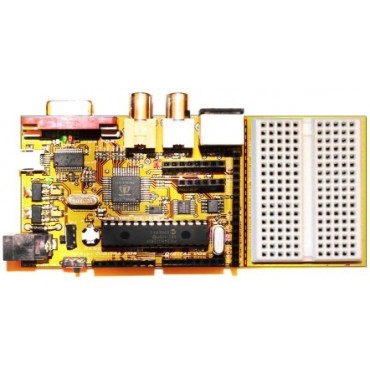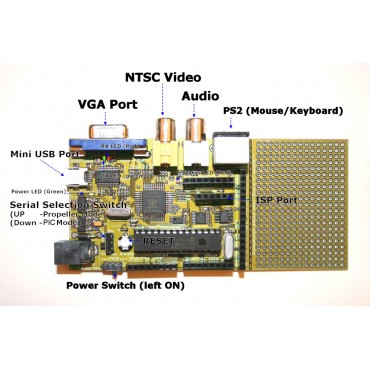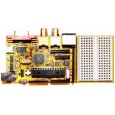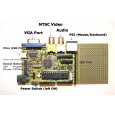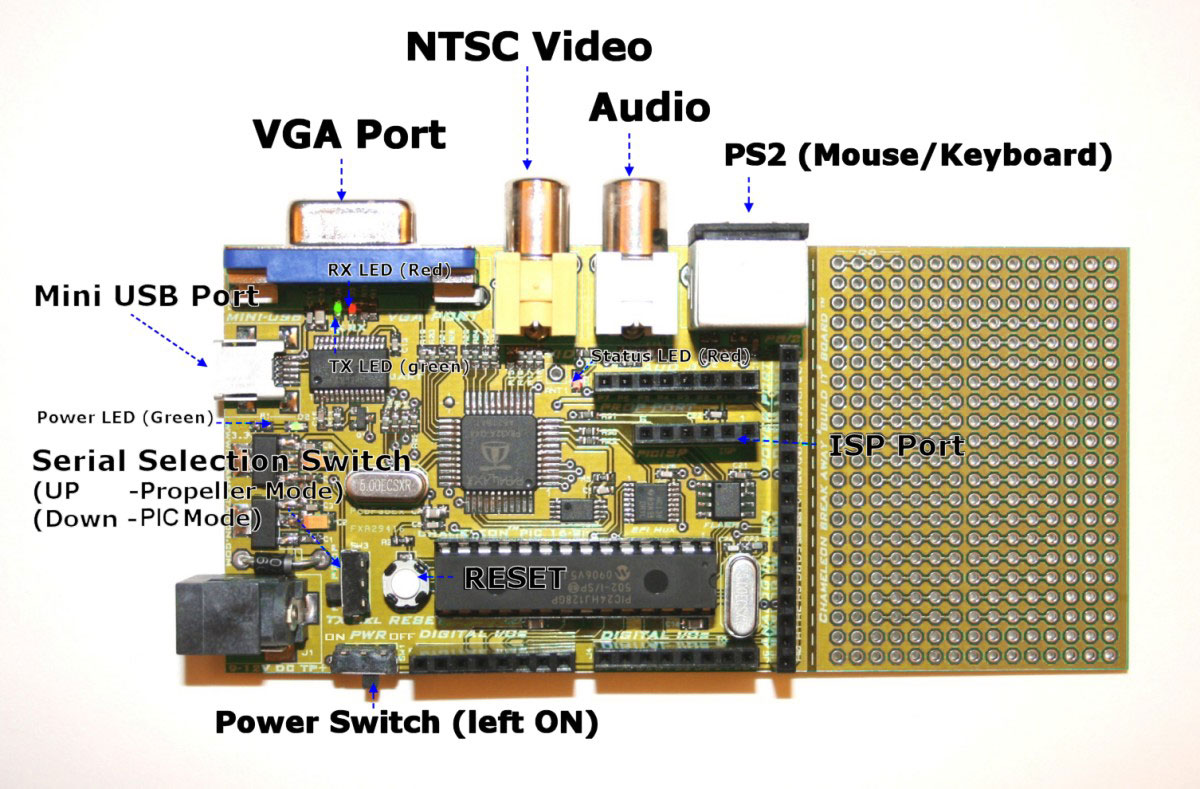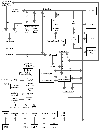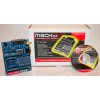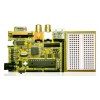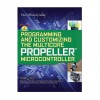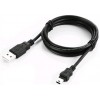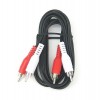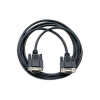Chameleon™ PIC 16-Bit System
Product Code: Cham-PIC16-01
Weight:2.00 lb
Reward Points:0
The Chameleon design is based on the concept of using the PIC24 as the MASTER (client) and the Propeller Multicore Processor as the media SLAVE (server). This is accomplished thru a SPI interface from the PIC to the Propeller (see images to right). The PIC sends "commands" to the Propeller chip via the SPI interface and a set of drivers on the Propeller (see images to right) parse, execute, and dispatch the messages to the various media objects running on the Propeller's multiple cores. Thus, printing characters on the NTSC screen from the PIC's point of view is as simple as sending 3 bytes thru the hardware SPI interface, the Propeller does all the rest with the supplied drivers.
If you're a PIC enthusiast, Propeller programmer, Arduino fan, or just someone that needs a very capable application board to solve problems and solve them fast, the Chameleon is the perfect tool. You can use as little or as much of the system as you wish due to the design of the sub-systems. You can use it as a PIC 16-bit system, Propeller multicore system, or tie the processors together, its up to you. Included with the package is the Chameleon itself as well as a 150+ page electronic manual on DVD that outlines how the Chameleon works with examples of using the media processing abilities. Also, the manual illustrates the hardware design, using MPLab, the Our Custom Text Editor Based Environment IDE, Propeller IDE, software installation, the API, and how to write your own drivers if you wish. But, best of all, you can get started immediately with the Chameleon and use the included API and program the PIC directly with MPLab or our Custom Text Editor based IDE.
The Chameleon also comes pre-loaded with theMicrochip bootloader, thus you can use the protocol compatible tools to program the Chameleon over the USB port without a Pickit2 compatible ISP (in system prgrammer). However, we recommend that you purchase a Pickit2 ISP programmer (or similar), so you can use MPLab to its fullest potential, debug, as well as re-burn the FLASH bootloader if you wish to do so (or if its damaged accidentally).
The Propeller is programmed with a simple serial protocol right over the USB serial port, so no additional hardware is required.
The Chameleon PIC 16-Bit has a full arsenal of I/O devices and features including:
- Runs Microchip PIC24 16-bit applications, as well as Parallax Propeller applications.
- Microchip PIC24HJ128GP502 16-bit processor with 128K FLASH / 8K SRAM running at 40 MIPS (pre-loaded with Microchip bootloader).
- Parallax Propeller Multicore 32-bit processor with 8 cores running at 20 MIPS per core for 160 MIPS of processing power!
- 1 MByte SPI FLASH memory.
- 64 Kbyte EEPROM (for Propeller processor boot program storage).
- 500mA max power 3.3/5V dual supplies (power by USB or external 9V DC supply with hot swapping).
- Mini USB port with USB to serial UART (FTDI chip), used for programming the Propeller, PIC in bootloader mode as well as serial comms.
- VGA output with 2x2x2 RGB.
- Composite video output for NTSC/PAL video.
- Microchip 6-pin ISP programming port for direct access to PIC (programmer not included).
- PS/2 keyboard/mouse port.
- I/O headers exporting digital, analog input inputs and power (95% compatibility with Arduino I/O headers).
- Exported SPI, Serial and I2C buses.
- Removable XTALs for overclocking.
NOTE: If you want to use MPLab to program and debug the Chameleon you must purchase a Microchip Pickit2 or similar ISP programmer. However, the Chameleon is pre-loaded with the Microchip bootloader, so with only a PC and a USB port you can program the Chameleon out of the box!
| Demos | |||
The programs written for the XGS PIC 16-Bit are easily portable to the Chameleon PIC 16-Bit |
Chameleon PIC User Manual Ver 1 (.pdf).
Chameleon PIC Software (.zip).
Chameleon PIC Bootloader (.zip).
Hello World Example Source Code (.txt).
The Chameleon™ PIC 16-Bit is the evolution of the high performance, small footprint, application development board. Similar to the BASIC Stamp™ and Arduino™ in concept, the Chameleon PIC takes these products to the next level with a huge leap in computational performance as well as I/O interfaces. Simply put, the Chameleon is a credit card sized computer with (2) processors, (9)processing cores, 1 MByte of on board FLASH, 64K of EEPROM, and over 200 MIPS of processing power! If that wasn't enough, the numerous I/O interfaces include composite video for NTSC/PAL generation, VGA, audio out, PS/2 for keyboards and mice. Additionally, the Chameleon has a number of digital I/Os and Analog inputs making the Chameleon perfect for industrial controllers, experimentation, education, wearable computing, or hobbyist use.
The real power of the Chameleon is based on its dual processor design. The Chameleon PIC uses the Microchip PIC24 16-bit as the main master processor (client) and Parallax multicore Propeller chip as the media processor (server). Thus, instead of taxing a single processor system to do everything, the Chameleon offloads all the heavy lifting to the multicore Propeller chip which has 8 processing cores to perform tasks such as generate video, audio, read keyboards and mice, etc. The PIC simply sends commands to the Propeller chip over a high speed SPI interface to command the Propeller to execute various operations all with a simple API that usually consists of a few lines of code to perform any task. Thus, the PIC programming is very simple and with simple APIs, you can develop very complex and rich media applications that leverage the incredibly powerful Propeller chip's media rendering abilities and huge software library. For example, you can generate TV signals, VGA, read keyboards and mice with a few lines of code.
Arduino I/O Compatibility
The Chameleon PIC 16-Bit was designed to be Arduino I/O compatible as much as possible, so programs written for the Arduino (or Chameleon AVR) in C/C++ could be easily ported to the Chameleon PIC as supported by the I/O headers. However, the Chameleon PIC 16-bit is over 200% faster than the Arduino and double the bandwidth since its a 16-bit processor. Additionally, the Chameleon PIC comes pre-programmed with a custom Microchip bootloader, so you can develop directly with a very simple text editor and set of batch files we have created that give the Chameleon PIC an "Arduino-like" development experience if you don't want to use the more complex MPLab. So right out of the box, all you need to program the Chameleon PIC is a USB cable and a PC.
Two Systems in One
The Chameleon is both a complete Microchip PIC24 16-bit application development board as well as Propeller development board. Both processors can be independently programmed and used. Additionally, the PIC and Propeller both have their own digital I/Os, so you theoretically you can run two applications on the Chameleon and use it that way or use the processors together over the SPI link. Also, the PIC system is 95% I/O compatible with the Arduino (headers are simply in different mechanical locations), so you can port Arduino software to the Chameleon PIC with a HUGE boost in performance! Moreover, the Propeller sub-system is compatible with most Propeller development boards and the HYDRA system, so the Chameleon will run most of those applications very little or no modification. Thus, the Chameleon is true to its name and truly is a "many in one" application system.
Chameleon Open-Source BASIC Language Support
We have written a complete BASIC programming language for the Chameleon, so you can code on the PC with a simple editor, compile and download to the Chameleon. Thus, you can choose from C/C++,Assembly Language or BASIC to program the Chameleon in. The BASIC is a work in progress with source code available, so you can use the source to write your own variants or complete new languages as well.
Last, but not least the Chameleon has a "break away" experimentation protoboard built into the PCB. You can solder directly onto it, or place the mini solderless breadboard that comes with the Chameleon onto the area with 2-sided tape. If you don't want the experimenter board, you simply "break" it away and snap it off.
Package Includes
- Chameleon PIC 16-Bit system (pre-loaded with Microchip bootloader, so you can program using the USB serial port and included tools).
- Mini solderless breadboard 1.25 x 2" (affixes to right hand side of Chameleon).
- 150+ page electronic manual covering hardware, software, and numerous programming tutorials.
- DVD-ROM including all tools, and numerous examples with complete driver library lncluding; Graphics, Sound, Keyboard, Mouse, Serial Comms, and lots more.
Bonus materials on DVD-ROM include electronic copies of:
- "Design Your Own Video Game Console", LaMothe.
- "Tricks of the Windows Game Programming Gurus", LaMothe.
- "The Black Art of 3D Game Programming", LaMothe.
- "How to Design and Build Your Own Custom TV Games", Heisermam.
NOTES: If you want to use MPLab to program and debug the Chameleon you must purchase a Microchip PicKit2 or similar ISP programmer. However, the Chameleon is pre-loaded with the Microchip bootloader, so with only a PC and a USB port you can program the Chameleon.


